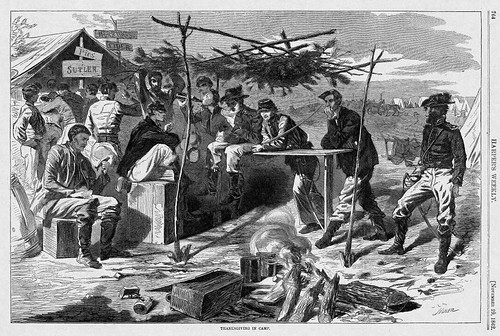
 Harper's Weekly, illustrations by Winslow Homer.
Harper's Weekly, illustrations by Winslow Homer.
Top: Harper's Weekly, 11/29/1862, Winslow Homer, "Thanksgiving in Camp."
Bottom: Harper's Weekly, 12/8/1864, Winslow Homer, "Thanksgiving-Day in the Army—After Dinner: The Wish-bone"
On the fourth Thursday in November of each year virtually every American citizen celebrates Thanksgiving Day in some form or another, either through traditional custom or individualized celebration. The Smithsonian American Art/National Portrait Gallery Library holds two monographs related to this holiday. Celebrations The Complete Book of American Holidays by Robert Myers states that one woman virtually started a movement to create this national holiday. She was Mrs. Sara Hale who ‘… started her crusade in 1827 while editor of the Boston Ladies’ Magazine and continued it with mounting success until the victory was won in1863 with President Abraham Lincoln’s Thanksgiving Day Proclamation.’
Harvest festivals can be traced back to most cultures throughout history in such observances as the corn harvest dance of the Cherokees, and the worship of Demeter the goddess of wheat in ancient Greece. The monograph maintains:
English fisherman in Newfoundland in 1578 had a Thanksgiving Day, and along the coast of Maine, in 1607, the Popham Colony set aside a day for giving thanks, Nevertheless, our present American November Thanksgiving finds its direct origin in the Pilgrim Fathers of Plymouth, Massachusetts, who, indeed, almost did not come to America.
The Pilgrims fled to Holland from their native England in order to avoid persecution for their religious beliefs. However, they were unable to adjust to their new status in Holland due to problems with the new language and inability to find well-paying jobs. They proposed a tobacco project in North America, which was sponsored by English businessmen. Two ships, the Speedwell and the Mayflower were leased for the journey, but the Speedwell did not prove to be seaworthy. Therefore, the Mayflower sailed with the “Saints,” as the Pilgrims were called, English emigrants, and servants. Robert Myers writes:
There were eighteen servants on board, most of who belonged to the Saints. Their period of indenture was normally seven years, during which time they were fed, clothed, and housed by their masters. However, they were not paid, did the hardest work, and, like slaves, could be bought and sold.
Landing in Plymouth, in December 1621, forty-seven Pilgrims died during the winter months. Those remaining survived due to the instruction and help of an Indian named Tisquantum (commonly known as Squanto) who taught them fishing, planting and home construction techniques necessary for life in North America. Squanto most probably acted as an interpreter to Massasoit, leader of the Wampanoag, who donated game, and accompanied by many braves, feasted with the Pilgrims.
The Smithsonian American Art/National Portrait Gallery Library houses two issues, November 29, 1862 and December 3, 1864, of Harper’s Weekly containing illustrations depicting troops celebrating Thanksgiving at the front. The illustrations were done for the newspaper by Winslow Homer (1836-1910), who is regarded as one of America’s finest artists. Born in Boston and raised in Cambridge, Massachusetts, he loved the outdoors. Homer's gift as a natural draftsman without the help of specialized art education allowed him to apprentice to lithographer J.H. Bufford at the age of nineteen. After his two-year apprenticeship he worked as a Civil War illustrator for Harper’s Weekly in New York. He changed the genre of military paintings from battle scenes with straight lines of soldiers following offices on horseback, or scenes of direct combat, to a more personalized depiction of the lives of individual soldiers, or the daily activities of the military camps. The engravings in the newspaper depict soldiers celebrating the holiday with little food, but still in high spirits.
A booklet from the Metropolitan Museum of Art, Thanksgiving & Harvest Festivals, states that American’s First President, 1789-1797, George Washington (1732-1799) issued the first presidential Thanksgiving Proclamation, but it was not universally observed until Abraham Lincoln issued the first nationwide Presidential Thanksgiving Proclamation on October 3, 1863. Margaret R. Scherer writes for the Metropolitan Museum of Art that the text of the proclamation provides his trust in the faith in the destiny of the country:
The year that is drawing toward its close has been filled with the blessings of fruitful fields and healthful skies … In the midst of a civil war of unequaled magnitude and severity, which has sometimes seemed to foreign states to invite and provoke their aggressions, peace has been preserved with all nations, order has been maintained, the laws have been respected and obeyed, and harmony has prevailed everywhere, except in the theater of military conflict; while that theater has been greatly contracted by the advancing armies and navies of the Union … . It has seemed to me fit and proper that they should be solemnly, reverently, and gratefully acknowledged as with one heart and one voice by the whole American people. I do, therefore, invite my fellow-citizens in every part of the United States, and also those who are at sea and those who are sojourning in foreign lands, to set apart and observe the last Thursday of November next as a day of thanksgiving and praise to our beneficent Father who dwelleth in the heavens … Lincoln’s Thanksgiving Proclamation
Happy Thanksgiving!
—Alice Clarke, Smithsonian American Art/National Portrait Gallery Library
CELEBRATIONS THE COMPLETE BOOK OF AMERICAN HOLIDAYS, ROBERT J. MYERS WITH THE EDITORS OF HALLMARK CARDS, ILLUSTRATIONS BY BILL GREER, DOUBLEDAY & COMPANY, INC. GARDEN CITY NEW YORK, 1972, GT4803A2M99 NPG, ISBN 0-385-07677-0
THANKSGIVING & HARVEST FESTIVALS, THE METROPOLITAN MUSEUM OF ART, MARGARET R. SCHERER, NEW YORK, 1942, 394.268N43

Be First to Comment